Fixed-Time Control of a Robotic Arm Based on Disturbance Observer Compensation
Abstract
:1. Introduction
- (1)
- Backstepping-based fixed-time tracking control is proposed in this article. Combining the backstepping, observer, and fixed time theory effectively improves the convergence speed and tracking precision of the robotic arm.
- (2)
- A fixed-time disturbance observer is designed to accurately estimate the system uncertainties existing in the robotic arm system, which provides compensation for the controller, thus improving the tracking performance and robustness of the robotic arm system. Meanwhile, we introduce the hyperbolic tangent function to avoid the observation chattering effect.
2. Preliminaries and Problem Formulation
2.1. Preliminaries
- (1)
- (2)
- If the solution satisfies the inequality as follows:
- (1)
- (2)
- If the solution satisfies the inequality as follows:
2.2. Problem Formulation
3. Controller Design without System Uncertainties
4. Controller Design with System Uncertainties
4.1. Disturbance Observer Design
4.2. Controller Design
5. Simulation Verification
6. Conclusions
Author Contributions
Funding
Data Availability Statement
Acknowledgments
Conflicts of Interest
References
- Zhou, J.; Li, Z.; Li, X.; Wang, X.; Song, R. Human–Robot Cooperation Control Based on Trajectory Deformation Algorithm for a Lower Limb Rehabilitation Robot. IEEE/ASME Trans. Mechatron. 2021, 26, 3128–3138. [Google Scholar] [CrossRef]
- Cheng, L.W.; Li, D.L.; Yu, G.J.; Zhang, Z.H.; Yu, S.Y. Robotic arm control system based on brain-muscle mixed signals. Biomed. Signal Process. Control 2022, 77, 103754. [Google Scholar] [CrossRef]
- Wu, Y.F.; Niu, W.K.; Kong, L.H.; Yu, X.B.; He, W. Fixed-time neural network control of a robotic manipulator with input deadzone. ISA Trans. 2023, 135, 449–461. [Google Scholar] [CrossRef] [PubMed]
- González-Rodríguez, A.; Baray-Arana, R.E.; Rodríguez-Mata, A.E.; Robledo-Vega, I.; Acosta Cano de los Ríos, P.R. Validation of a Classical Sliding Mode Control Applied to a Physical Robotic Arm with Six Degrees of Freedom. Processes 2022, 10, 2699. [Google Scholar] [CrossRef]
- Zhou, X.Y.; Wang, H.P.; Wu, K.; Zheng, G. Fixed-time neural network trajectory tracking control for the rigid-flexible coupled robotic mechanisms with large beam-deflections. Appl. Math. Model. 2023, 118, 665–691. [Google Scholar] [CrossRef]
- Hernandez-Sanchez, A.; Chairez, I.; Matehuala-Moran, I.; Alfaro-Ponce, M.; Molina, A. Trajectory tracking controller of a robotized arm with joint constraints, a direct adaptive gain with state limitations approach. ISA Trans. 2023, 141, 276–287. [Google Scholar] [CrossRef] [PubMed]
- Jia, Y.G.; Misra, A.K. Robust trajectory tracking control of a dual-arm space robot actuated by control moment gyroscopes. Acta Astronaut. 2017, 137, 287–301. [Google Scholar] [CrossRef]
- Mai, T.L.; Tran, H.T. An adaptive robust backstepping improved control scheme for mobile manipu lators robot. ISA Trans. 2023, 137, 446–456. [Google Scholar] [CrossRef]
- Tuan, L.A.; Joo, Y.H.; Tien, L.Q.; Duong, P.X. Adaptive neural network second-order sliding mode control of dual arm robots. Int. J. Control 2017, 15, 2883–2891. [Google Scholar] [CrossRef]
- Wang, H.; Liu, P.X.; Zhao, X.; Liu, X. Adaptive Fuzzy Finite-Time Control of Nonlinear Systems with Actuator Faults. IEEE Trans. Cybern. 2020, 50, 1786–1797. [Google Scholar] [CrossRef]
- Dong, G.; Li, H.; Ma, H.; Lu, R. Finite-Time Consensus Tracking Neural Network FTC of Multi-Agent Systems. IEEE Trans. Neural Netw. Learn. Syst. 2021, 32, 653–662. [Google Scholar] [CrossRef] [PubMed]
- Van, M.; Mavrovouniotis, M.; Ge, S.S. An Adaptive Backstepping Nonsingular Fast Terminal Sliding Mode Control for Robust Fault Tolerant Control of Robot Manipulators. IEEE Trans. Syst. Man Cybern. Syst. 2019, 49, 1448–1458. [Google Scholar] [CrossRef]
- Yang, P.; Su, Y.X.; Zhang, L.Y. Proximate fixed-time fault-tolerant tracking control for robot manipulators with prescribed performance. Automatica 2023, 157, 111262. [Google Scholar] [CrossRef]
- Shi, S.; Gu, J.; Xu, S.; Min, H. Globally Fixed-Time High-Order Sliding Mode Control for New Sliding Mode Systems Subject to Mismatched Terms and Its Application. IEEE Trans. Ind. Electron. 2020, 67, 10776–10786. [Google Scholar] [CrossRef]
- Zhang, L.; Liu, H.; Tang, D.; Hou, Y.; Wang, Y. Adaptive Fixed Time Fault-Tolerant Tracking Control and Its Application for Robot Manipulators. IEEE Trans. Ind. Electron. 2021, 69, 2956–2966. [Google Scholar] [CrossRef]
- Jin, X. Adaptive Fixed-Time Control for MIMO Nonlinear Systems With Asymmetric Output Constraints Using Universal Barrier Functions. IEEE Trans. Autom. Control 2019, 64, 3046–3053. [Google Scholar] [CrossRef]
- Hua, C.; Ning, P.; Li, K.; Guan, X. Fixed-Time Prescribed Tracking Control for Stochastic Nonlinear Systems with Unknown Measurement Sensitivity. IEEE Trans. Cybern. 2022, 52, 3722–3732. [Google Scholar] [CrossRef]
- Rahimi, S.; Jalali, H.; Mohammad, R.H.Y.; Kalhor, A.; Masouleh, M.T. Design and practical implementation of a Neural Network self-tuned Inverse Dynamic Controller for a 3-DoF Delta parallel robot based on Arc Length Function for smooth trajectory tracking. Mechatronics 2022, 84, 102772. [Google Scholar] [CrossRef]
- Hu, J.B.; Zhang, D.; Wu, Z.G.; Li, H.Y. Neural network-based adaptive second-order sliding mode control for uncertain manipulator systems with input saturation. ISA Trans. 2023, 136, 126–138. [Google Scholar] [CrossRef]
- Zhu, C.; Jiang, Y.; Yang, C. Fixed-Time Neural Control of Robot Manipulator With Global Stability and Guaranteed Transient Performance. IEEE Trans. Ind. Electron. 2023, 70, 803–812. [Google Scholar] [CrossRef]
- Liang, X.L.; Wang, H.B.; Zhang, Y.X. Adaptive nonsingular terminal sliding mode control for rehabilitation robots. Comput. Electr. Eng. 2022, 99, 107718. [Google Scholar] [CrossRef]
- Zhou, X.Y.; Wang, H.P.; Wu, K.; Tian, Y.; Zheng, G. Nonlinear disturbance observer-based robust predefined time tracking and vibration suppression control for the rigid-flexible coupled robotic mechanisms with large beam-deformations. Comput. Math. Appl. 2023, 148, 1–25. [Google Scholar] [CrossRef]
- Yao, Q. Dual-disturbance-observer-based robust finite-time trajectory tracking control for robotic surface vehicle under measurement uncertainties. Ocean. Eng. 2021, 242, 110183. [Google Scholar] [CrossRef]
- Ullah, I.; Pei, H.-L. Fixed Time Disturbance Observer Based Sliding Mode Control for a Miniature Unmanned Helicopter Hover Operations in Presence of External Disturbances. IEEE Access 2020, 8, 73173–73181. [Google Scholar] [CrossRef]
- Vo, A.T.; Truong, T.N.; Kang, H.-J.; Van, M. A Robust Observer-Based Control Strategy for n-DOF Uncertain Robot Manipulators with Fixed-Time Stability. Sensors 2021, 21, 7084. [Google Scholar] [CrossRef] [PubMed]
- Zou, Z.Y.; Tie, L. A new class of finite-time nonlinear consensus protocols for multi-agent systems. Int. J. Control 2014, 87, 363–370. [Google Scholar]
- Fu, J.J.; Wang, J.Z. Fixed-time coordinated tracking for second-order multiagent systems with bounded input uncertainties. Syst. Control Lett. 2016, 93, 1–12. [Google Scholar] [CrossRef]
- Su, B.; Wang, H.-b.; Wang, Y. Dynamic event-triggered formation control for AUVs with fixed-time integral sliding mode disturbance observer. Ocean. Eng. 2021, 240, 109893. [Google Scholar] [CrossRef]
- Zuo, Z.Y. Nonsingular fixed-time consensus tracking for second-order multi-agent networks. Automatica 2015, 54, 305–309. [Google Scholar] [CrossRef]
- He, W.; Ge, S.S.; Li, Y.; Chew, E.; Ng, Y.S. Neural Network Control of a Rehabilitation Robot by State and Output Feedback. J. Intell. Robot. Syst. 2015, 80, 15–31. [Google Scholar] [CrossRef]

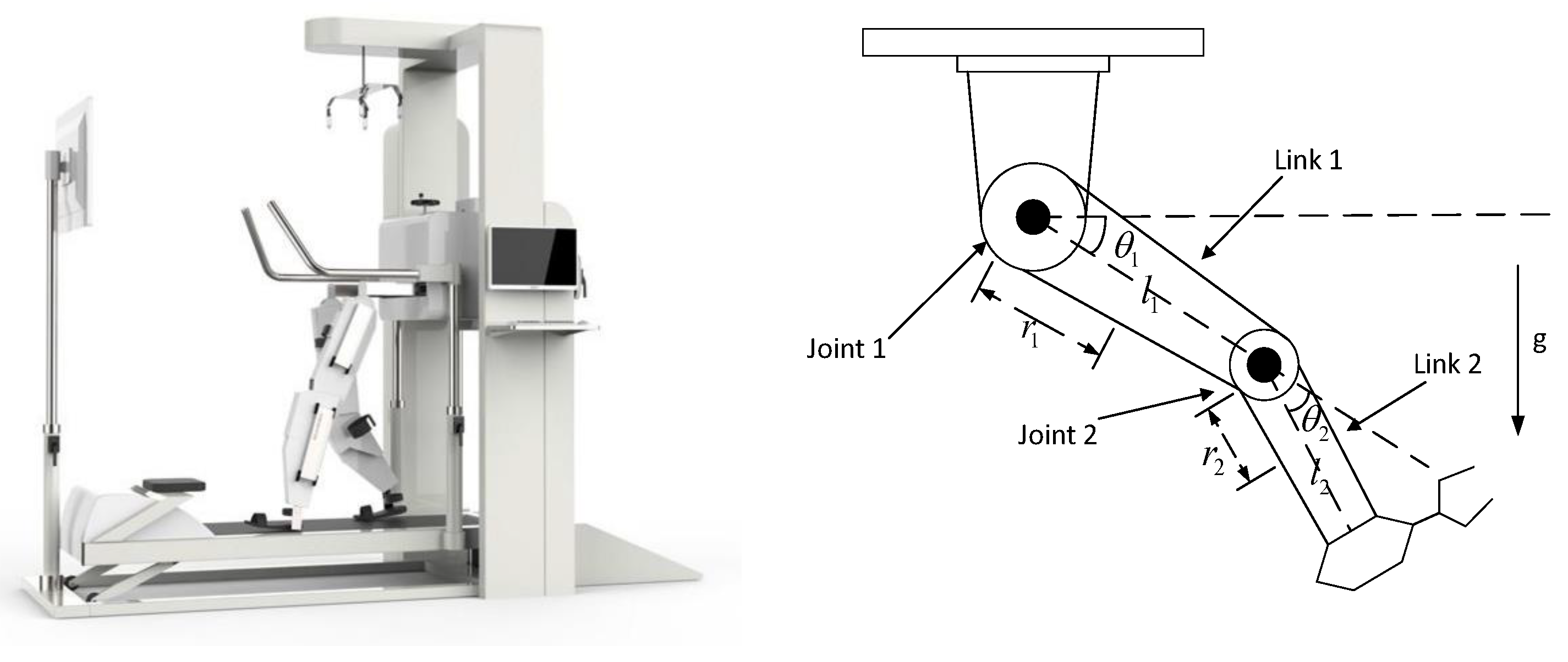
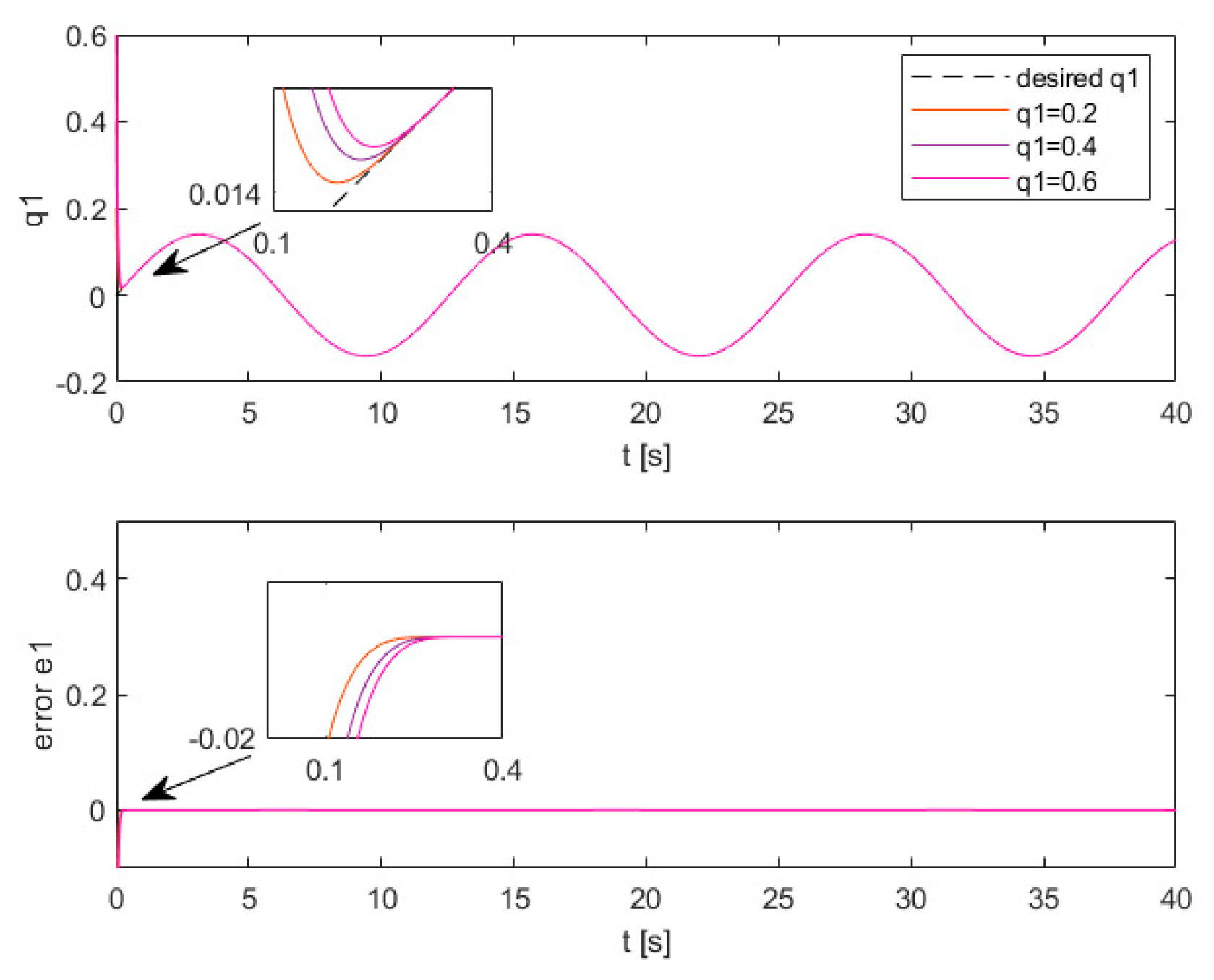
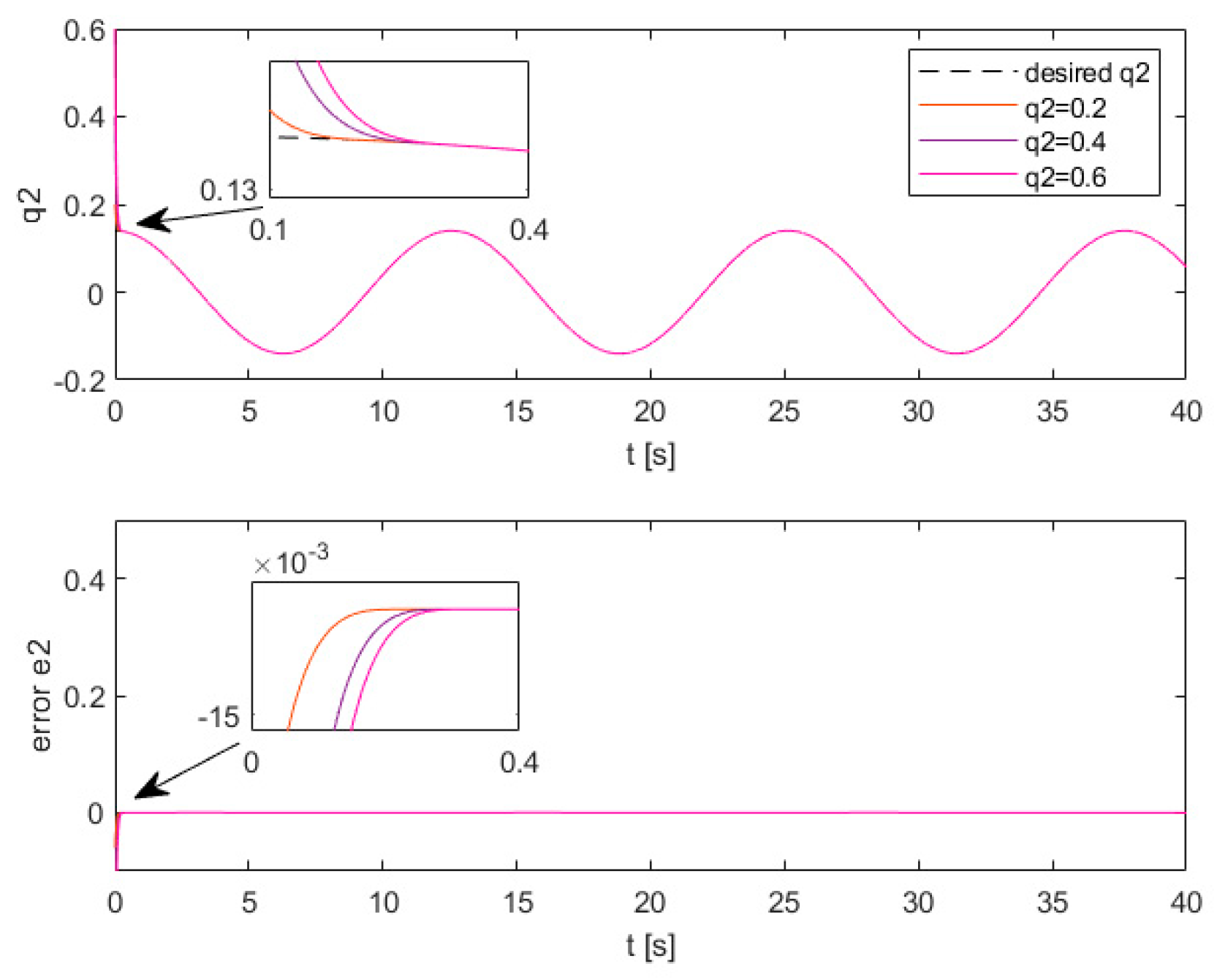
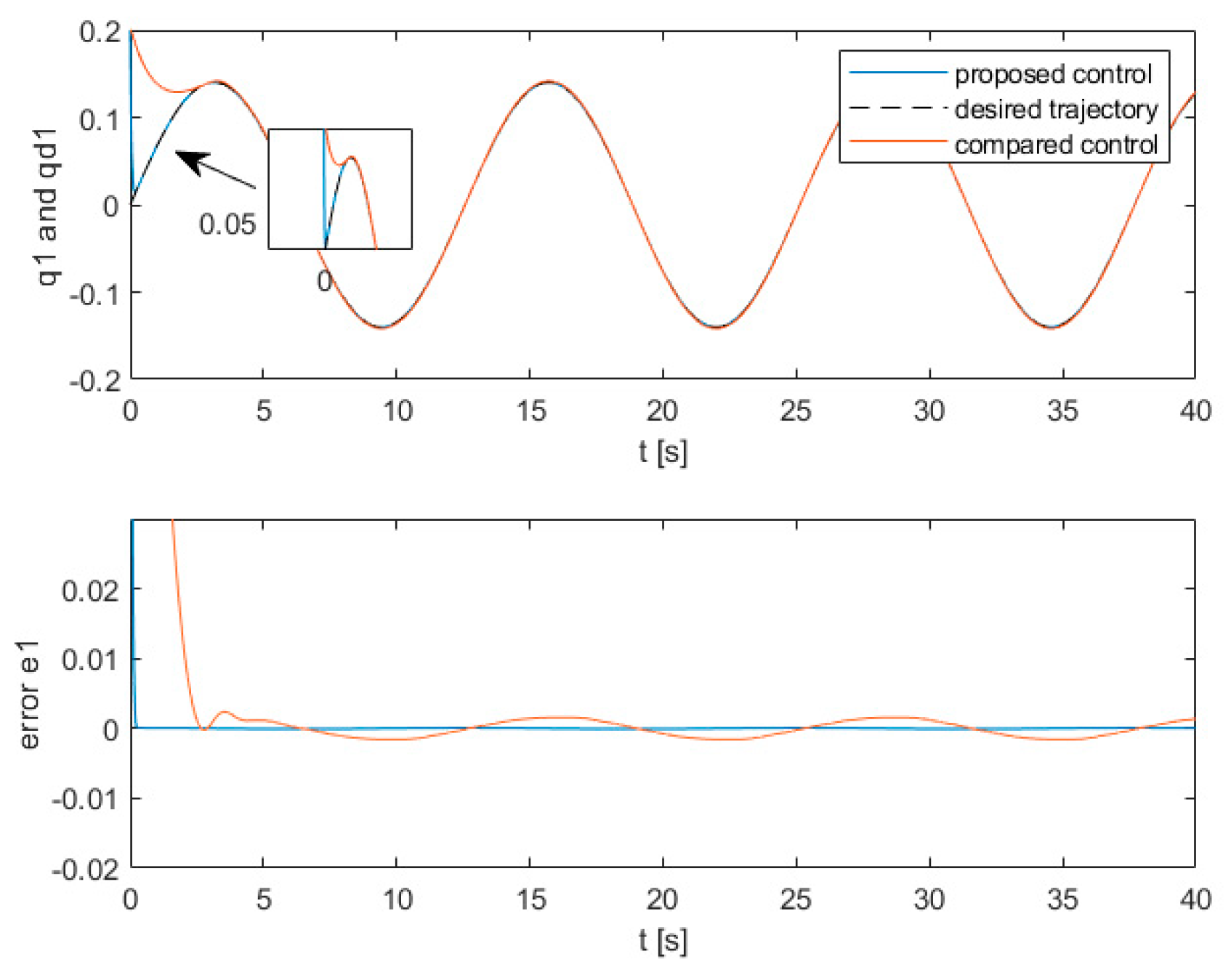
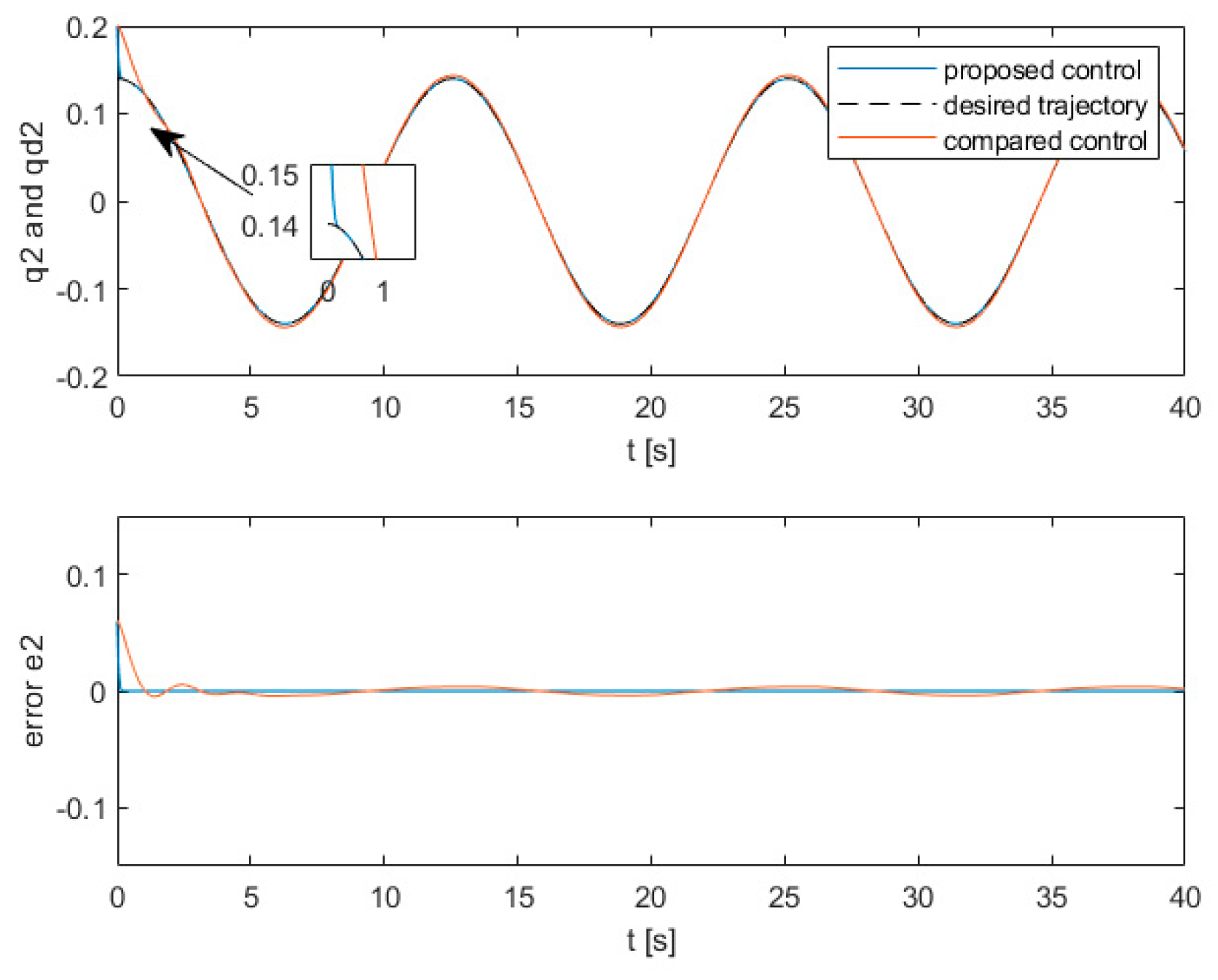
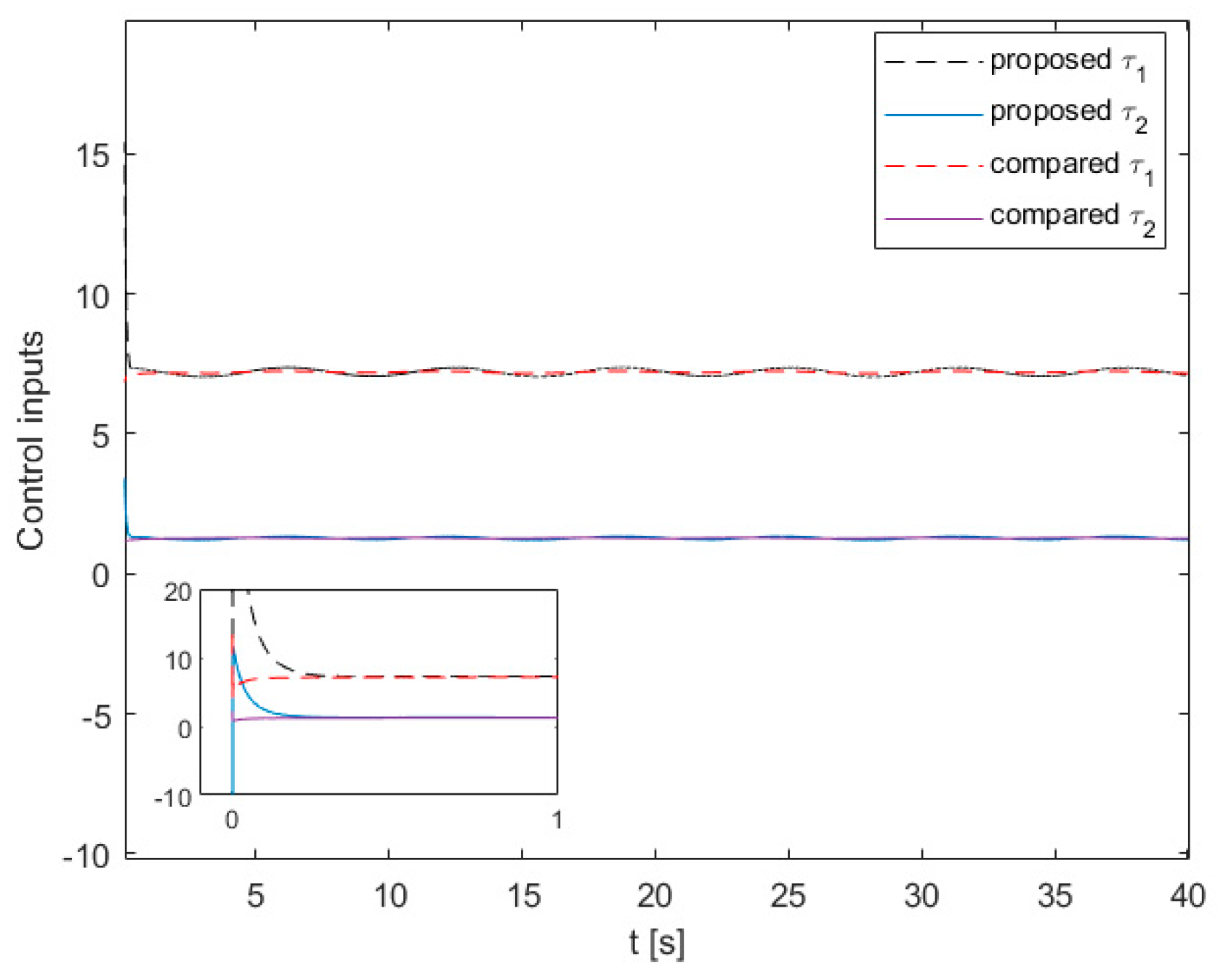
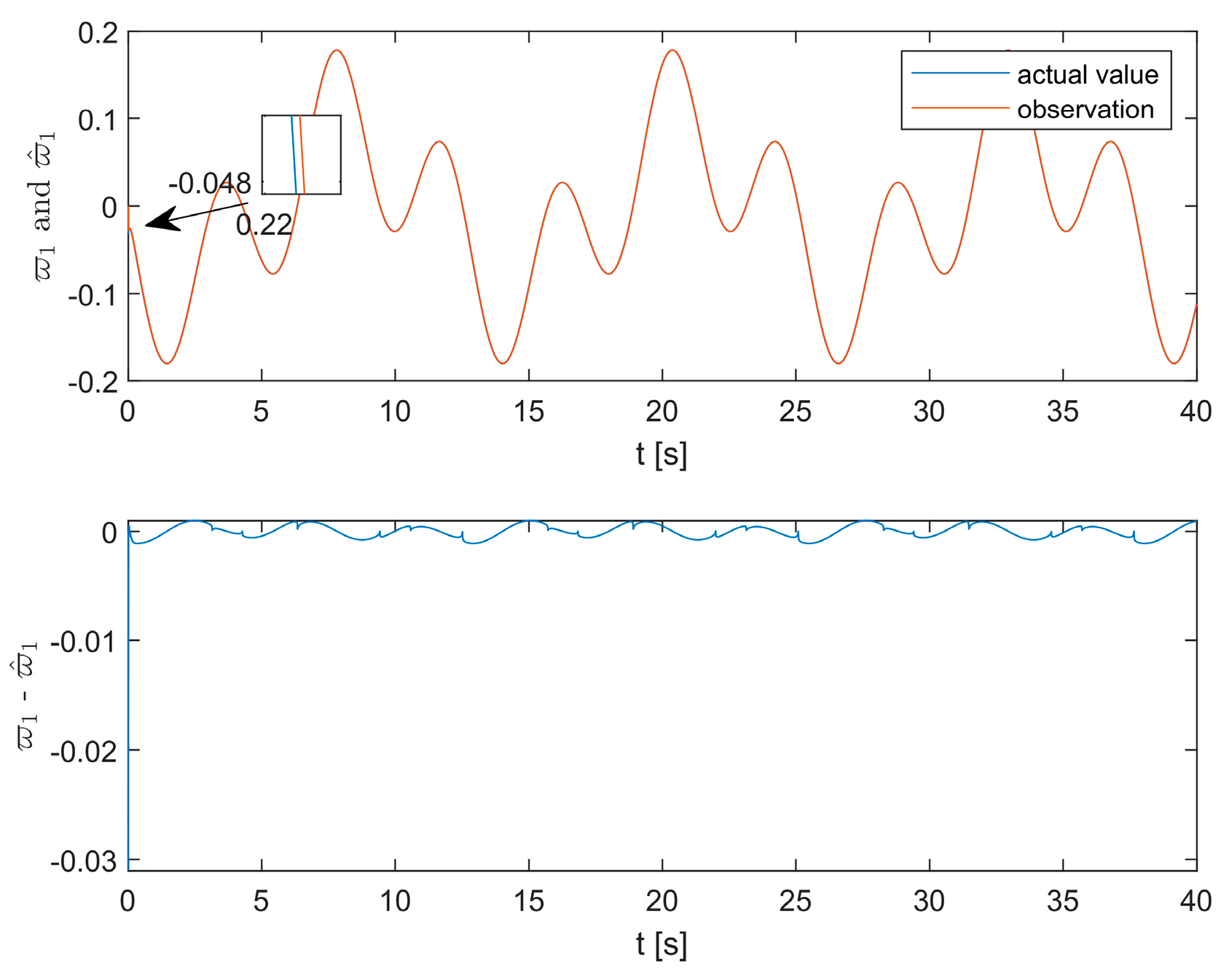
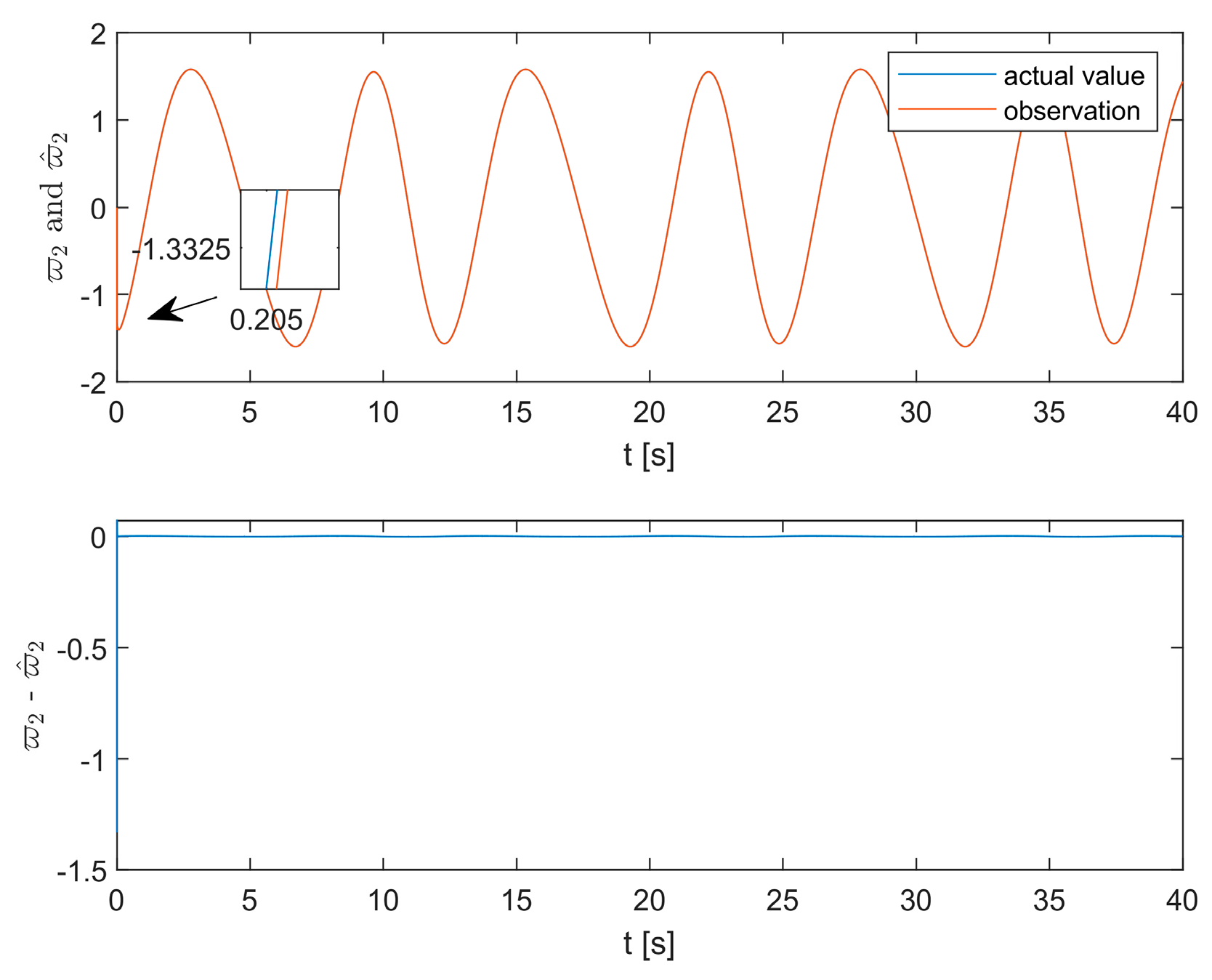
| Parameter | Description | Value |
|---|---|---|
| Mass of link 1 | 2.00 kg | |
| Mass of link 2 | 0.85 kg | |
| Length of link 1 | 0.35 m | |
| Length of link 2 | 0.31 m | |
| Moment of inertia of link 1 | 0.06125 kgm2 | |
| Moment of inertia of link 2 | 0.02042125 kgm2 |
Disclaimer/Publisher’s Note: The statements, opinions and data contained in all publications are solely those of the individual author(s) and contributor(s) and not of MDPI and/or the editor(s). MDPI and/or the editor(s) disclaim responsibility for any injury to people or property resulting from any ideas, methods, instructions or products referred to in the content. |
© 2023 by the authors. Licensee MDPI, Basel, Switzerland. This article is an open access article distributed under the terms and conditions of the Creative Commons Attribution (CC BY) license (https://creativecommons.org/licenses/by/4.0/).
Share and Cite
Zhang, G.; Pan, J.; Li, T.; Wang, Z.; Wang, D. Fixed-Time Control of a Robotic Arm Based on Disturbance Observer Compensation. Processes 2024, 12, 93. https://doi.org/10.3390/pr12010093
Zhang G, Pan J, Li T, Wang Z, Wang D. Fixed-Time Control of a Robotic Arm Based on Disturbance Observer Compensation. Processes. 2024; 12(1):93. https://doi.org/10.3390/pr12010093
Chicago/Turabian StyleZhang, Gang, Jing Pan, Tianli Li, Zheng Wang, and Duansong Wang. 2024. "Fixed-Time Control of a Robotic Arm Based on Disturbance Observer Compensation" Processes 12, no. 1: 93. https://doi.org/10.3390/pr12010093
APA StyleZhang, G., Pan, J., Li, T., Wang, Z., & Wang, D. (2024). Fixed-Time Control of a Robotic Arm Based on Disturbance Observer Compensation. Processes, 12(1), 93. https://doi.org/10.3390/pr12010093






